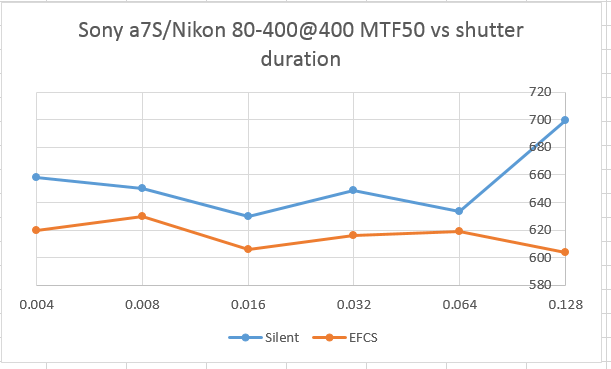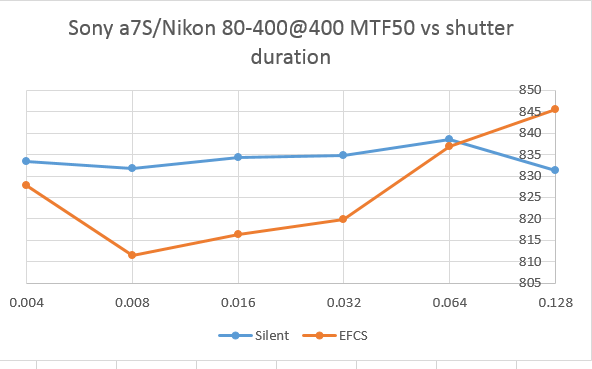I’ve already established that electronic first curtain shutter can provide sharper tripod-mounted images with the Sony a7 than with the all-mechanical shutter mode on that camera and the all-mechanical shutter on the a7R. I wondered if using the a7S in all-electronic shutter mode — aka silent shutter — would provide any benefits.
I took the longest lens I have that will take a 77mm filter: the Nikon AFS-Nikkor 80-400mm f/4.5-5.6 G ED, and mounted it to the a7S with a Metabones adapter. Using the rotating foot, I clipped the lens, in landscape orientation into an Arca Swiss C1 head which was attached to a set of RRS TVC-44 legs.
I mounted a Heliopan variable ND filter on the lens. I lit an Imatest SFRPlus target with a Fotodiox 5500K variable output LED source. I set the ISO to 400, focused wide open, and set the aperture to f/11. Using the ND filter and the light together to control the, and made a series of exposures of durations from 1/250 second through 1/8 second at 1 stop intervals. I controlled the number of photons hitting the sensor with the ND filter.
Then I did it again.
I processed the images in Lightroom 5.6 with default settings except for cropping and white balance, then I processed them in Imatest, measuring the MTF50 for horizontal edges. I converted the Imatest cycles/pixel data to cycles/picture height, and made plots.
Noisy results. It looks like the all electronic shutter helps a little, but not much. If I could have performed the testing with a sharper lens, it might have helped more.


Jack Hogan says
Hi Jim,
“…focused wide open, and set the aperture to f/…”
That was also my procedure up to this week, but after reading the following paper by Dr. Nasse I wonder if we are not shortchanging the system when we do that. The paper infers on page 36 that focusing wide open and then changing aperture substantially may (will in typical photographic lenses) result in a shift of the optimal focus plane as a result of the changed blend in Spherical Aberrations. Perhaps at f/11 in lab conditions it would still be best to focus in liveview (or focus peak) at that aperture?
http://www.zeiss.com/content/dam/Photography/new/pdf/en/cln_archiv/cln35_en_web_special_bokeh.pdf
Jack
Jim says
Jack, I’ve struggled with this issue for a while. If you can focus a stopped-down lens with great accuracy, I’m sure that you want to focus stopped down. On SLR ground classes that had clear centers with black crosses, I used the move your head technique (if the image doesn’t move wrt the cross, it’s in focus) to great effect of stopped down lenses. I haven’t had such good results with live view, but, as LV gets better, focusing stopped-down probably becomes more attractive.
Oh, Lord. Something else to test. Thanks, Jack…
…I think.
Jim